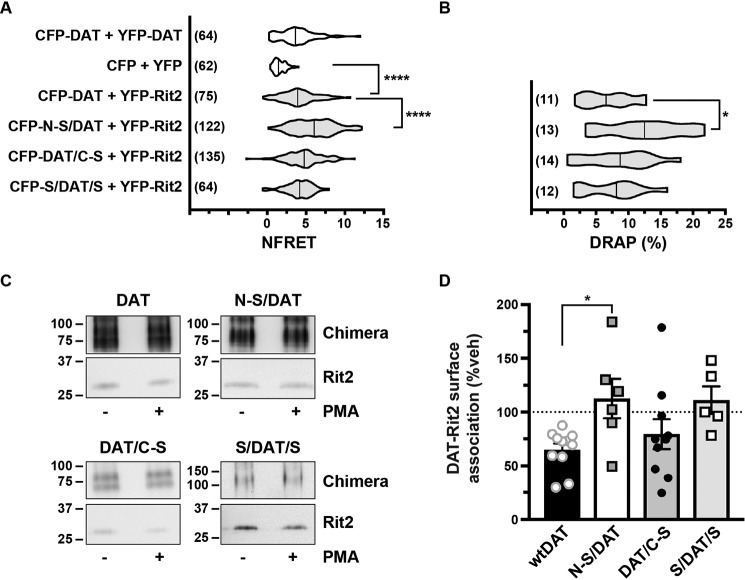Figure 7.
The SERT N terminus promotes the DAT-Rit2 interaction and blocks PKC-stimulated DAT-Rit2 dissociation. A and B, FRET studies. HEK293 cells were transfected with the indicated plasmids, and surface FRET measurements were made 24 h post-transfection, as described under “Experimental procedures.” Average NFRET values (×100) for the indicated pairs are presented as violin plots, with median lines provided within each violin. n values are provided for each violin. A, NFRET values. Asterisks, significant differences between the indicated pairs (Kruskal–Wallis test, p < 0.0001 with Dunn's multiple comparisons test: DAT versus N-S/DAT: ****, p < 0.0001; versus DAT/C-S: p = 0.13; versus S/DAT/S: p > 0.99; versus CFP/YFP: ****, p < 0.0001). B, DRAP values (one-way ANOVA F(3, 46) = 3.31, p = 0.028; Dunnett's multiple-comparison test: DAT versus N-S/DAT: *, p = 0.02; DAT/C-S: p = 0.81; versus S/DAT/S: p = 0.99). C and D, BBS-DAT pull-downs. HEK293T cells were co-transfected with HA-Rit2 and the indicated BBS-tagged proteins. Cells were treated with or without 1 μm PMA for 30 min at 37 °C and surface-labeled with α-BTX-b, and DAT surface complexes were recovered by streptavidin pulldown as described under “Experimental procedures.” C, representative immunoblots. D, average data presented as percentage of vehicle-treated DAT-Rit2 association for each indicated protein. N-S/DAT significantly blocked PKC-stimulated DAT-Rit2 dissociation (one-way ANOVA F(3, 28) = 3.44, p = 0.03; Dunnett's multiple-comparison test: DAT versus N-S/DAT: *, p = 0.03; versus DAT/C-S: p = 0.69; versus S/DAT/S: p = 0.06, n = 5–11). Error bars, S.E.

